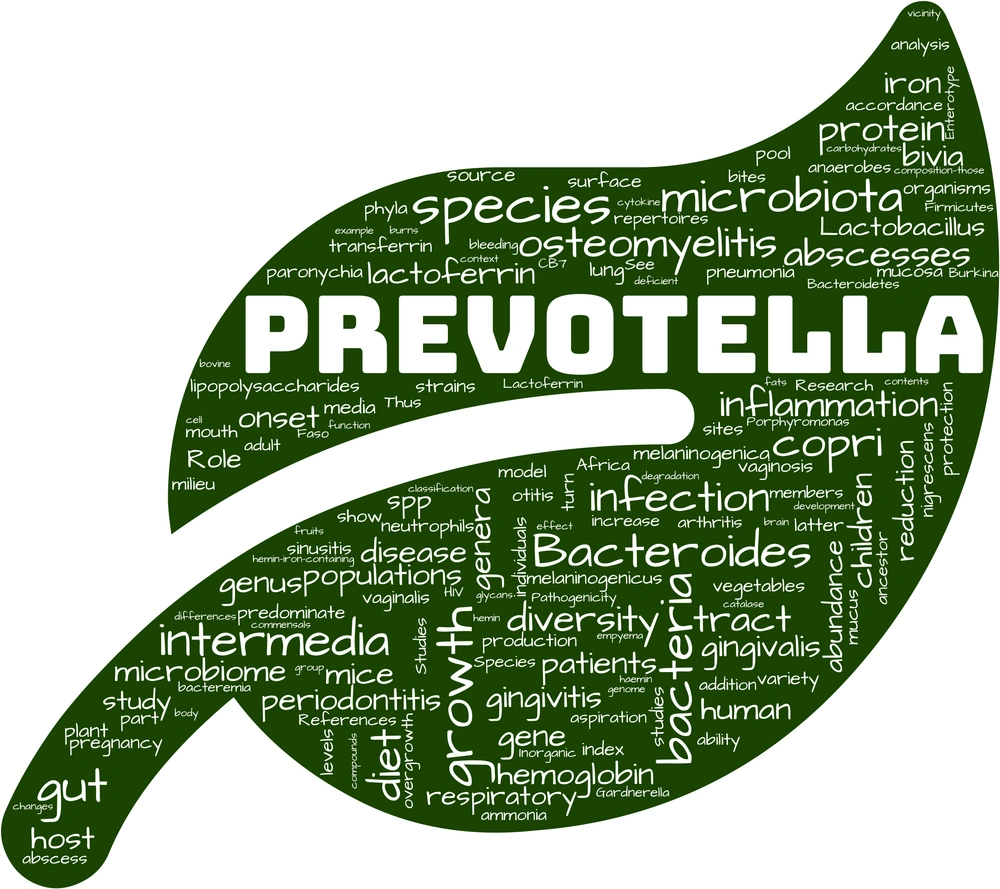
The Role of Prevotella in the Microbiome
Bacteroidetes is one of the dominant phyla in the human gut. Depending on your dietary background, Prevotella or Bacteroides will be the dominant genera in this phylum. Research associates Bacteroides with western diets, higher in fat and protein and Prevotella with plant-rich diets, abundant in carbohydrates and fiber. Typically, people from Europe and North America are Bacteroides dominant while people from East Asia, Africa and South America are Prevotella-dominant.
Prevotella is considered a commensal in the human gut, meaning that it is normal to find Prevotella in the gut, but if it is too abundant, it may not be healthy. However, much more research is needed to fully understand the role Prevotella plays in human health. There is a lot of diversity amongst individual Prevotella species, so the health impacts may depend on exactly which Prevotella are present in the gut. Current research indicates that Prevotella copri is the most abundant type of Prevotella found in the human gut. Prevotella stercorea is also common.
Some studies associate Prevotella with improved cardiovascular health and blood sugar, while others associate Prevotella with metabolic syndrome, insulin resistance, hypertension, obesity, inflammatory bowel disease, and rheumatoid arthritis. The research is quite conflicting. This is most likely due to the genetic diversity of Prevotella. Recent research indicates that Prevotella copri has at least four genetically distinct lineages. So it may be that one Prevotella copri lineage has beneficial impacts while another can be inflammatory. Research also indicates unclassified Prevotella is common in the human gut, so further research is needed to characterize these lineages.
Diet may play a role in shaping the genetic variation of Prevotella copri in the microbiome. Prevotella copri in omnivores compared to vegetarians has a higher genetic capacity to metabolize branched chain amino acids, sulfur, and drugs. Prevotella copri in vegetarians, however, has a higher genetic capacity to make vitamins such as folate and break down carbohydrates like glucan. This may lead to different health outcomes depending on the strain of Prevotella copri.
Research also demonstrates a wide range in relative abundance of Prevotella in the human gut based on geographic location. In places like Fiji and Tangshan, about half the population has 20-70% relative abundance of Prevotella. While in the US, the majority of the population has less than 1% and up to 6% relative abundance. So the optimal abundance of Prevotella may depend on your geographic location or your traditional diet.
In current clinical practice, addressing Prevotella depends on the patient. What is their geographic location? What is their diet like? What about their childhood diet? What symptoms or conditions does the patient have? If the patient is from North America or western Europe with a traditional diet higher in fat and protein from animal sources, higher Prevotella levels may be clinically significant. However, if the patient is from India and eats a traditional Indian diet (even if they now are located in North America) and they report no signs and symptoms of disease, a relative abundance of 40% Prevotella may not be clinically significant. We need more research that identifies the specific Prevotella strains, as well as at what relative abundance in which populations, to fully understand clinical impact.
While much more research is needed, we may only need to be concerned about higher Prevotella levels in those in Western cultures. This may be true even in vegetarians, as research demonstrates the same Prevotella levels in Western omnivores and vegetarians.
High Prevotella levels may be of particular concern if Prevotella levels spike with no change in diet. Prevotella spikes have been seen in recent years following COVID-19 infection in some patients. These spikes can range from less than 5% Prevotella pre-COVID to greater than 50% weeks after COVID-19. Please note that this is not seen in all patients with COVID-19 and the research does associate higher Prevotella levels with other viral infections.
One proposed mechanism is the mouth-gut axis. In addition to colonizing the human gut, Prevotella also colonizes the oral cavity. Research shows increased levels of Prevotella in the nasopharyngeal and oral cavity after COVID-19 infection. When ingested, the oral bacteria may translocate to the lower digestive tract. It is unclear if Prevotella from the oral microbiome is colonizing the digestive tract or simply temporarily translocating in much higher amounts. Prevotella melaninogenica, Prevotella nigrescens, and Prevotella pallens are the species typically found in the oral cavity. Prevotella nigrescens has been associated with periodontitis, driving Th17 mediated inflammation in the oral cavity as well as throughout the body.
Tools that may help to lower Prevotella in the digestive tract include olive leaf, slippery elm, triphala, and lauric acid. In clinical practice, triphala has demonstrated moderate clinical effect, however, much more research is needed to understand the impact of these nutraceuticals on specific strains of Prevotella. An alternative approach may to focus on balancing the oral or nasopharyngeal microbiome. Nasal lavage utilizing xylitol, mouth washes utilizing xylitol, and oral prebiotics with strains of Streptococcus salivarius may be beneficial. If a viral infection may be the cause of Prevotella overgrowth, then antiviral therapies may have benefit or supporting immune function in the intestines by increasing secretory IgA may have benefit. Colostrum and serum bovine immunoglobulin supplements contain IgA, while supplements like Saccharomyces boulardii and reishi mushroom may increase endogenous production of secretory IgA. These strategies and tools are theoretical with some anecdotal evidence. Further research is necessary to substantiate these ideas.
Please remember to always speak to your health care provider before making any changes to your diet, supplements, or medications.
References
Prasoodanan P. K. V, Sharma AK, Mahajan S, et al. Western and non-western gut microbiomes reveal new roles of Prevotella in carbohydrate metabolism and mouth–gut axis. npj Biofilms Microbiomes. 2021;7(1):1-17. doi:10.1038/s41522-021-00248-x
Tett A, Huang KD, Asnicar F, et al. The Prevotella copri Complex Comprises Four Distinct Clades Underrepresented in Westernized Populations. Cell Host & Microbe. 2019;26(5):666-679.e7. doi:10.1016/j.chom.2019.08.018
Larsen JM. The immune response to Prevotella bacteria in chronic inflammatory disease. Immunology. 2017;151(4):363-374. doi:10.1111/imm.12760
Tamanai-Shacoori Z, Le Gall-David S, Moussouni F, et al. SARS-CoV-2 and Prevotella spp.: friend or foe? A systematic literature review. J Med Microbiol. 2022;71(5). doi:10.1099/jmm.0.001520
Hristov AN, Callaway TR, Lee C, Dowd SE. Rumen bacterial, archaeal, and fungal diversity of dairy cows in response to ingestion of lauric or myristic acid. J Anim Sci. 2012;90(12):4449-4457. doi:10.2527/jas.2011-4624
Chung WSF, Walker AW, Bosscher D, et al. Relative abundance of the Prevotella genus within the human gut microbiota of elderly volunteers determines the inter-individual responses to dietary supplementation with wheat bran arabinoxylan-oligosaccharides. BMC Microbiology. 2020;20(1):283. doi:10.1186/s12866-020-01968-4
Ren W, Yan H, Yu B, et al. Prevotella-rich enterotype may benefit gut health in finishing pigs fed diet with a high amylose-to-amylopectin ratio. Animal Nutrition. 2021;7(2):400-411. doi:10.1016/j.aninu.2020.08.007
Prevotella species in the human gut is primarily comprised of Prevotella copri, Prevotella stercorea and related lineages | Scientific Reports. Accessed January 11, 2023. https://www.nature.com/articles/s41598-022-12721-4
Peterson CT, Sharma V, Uchitel S, et al. Prebiotic Potential of Herbal Medicines Used in Digestive Health and Disease. The Journal of Alternative and Complementary Medicine. 2018;24(7):656-665. doi:10.1089/acm.2017.0422
Oral Prevotella Species and Their Connection to Events of Clinical Relevance in Gastrointestinal and Respiratory Tracts - PMC. Accessed January 16, 2023. https://www.ncbi.nlm.nih.gov/pmc/articles/PMC8770924/
Haran JP, Bradley E, Zeamer AL, et al. Inflammation-type dysbiosis of the oral microbiome associates with the duration of COVID-19 symptoms and long COVID. JCI Insight. 2021;6(20). doi:10.1172/jci.insight.152346
Karygianni L, Cecere M, Skaltsounis AL, et al. High-Level Antimicrobial Efficacy of Representative Mediterranean Natural Plant Extracts against Oral Microorganisms. BioMed Research International. 2014;2014:e839019. doi:10.1155/2014/839019
Precup G, Vodnar DC. Gut Prevotella as a possible biomarker of diet and its eubiotic versus dysbiotic roles: a comprehensive literature review. Br J Nutr. 2019;122(2):131-140. doi:10.1017/S0007114519000680
De Filippis F, Pasolli E, Tett A, et al. Distinct Genetic and Functional Traits of Human Intestinal Prevotella copri Strains Are Associated with Different Habitual Diets. Cell Host & Microbe. 2019;25(3):444-453.e3. doi:10.1016/j.chom.2019.01.004
Pais P, Almeida V, Yılmaz M, Teixeira MC. Saccharomyces boulardii: What Makes It Tick as Successful Probiotic? Journal of Fungi. 2020;6(2):78. doi:10.3390/jof6020078
Kubota A, Kobayashi M, Sarashina S, et al. Reishi mushroom Ganoderma lucidum Modulates IgA production and alpha-defensin expression in the rat small intestine. J Ethnopharmacol. 2018;214:240-243. doi:10.1016/j.jep.2017.12.010
Van Arsdall M, Haque I, Liu Y, Rhoads JM. Is There a Role for the Enteral Administration of Serum-Derived Immunoglobulins in Human Gastrointestinal Disease and Pediatric Critical Care Nutrition?1. Adv Nutr. 2016;7(3):535-543. doi:10.3945/an.115.011924
Categories: ASD autism diet prevotella Research Tags: prevotella
